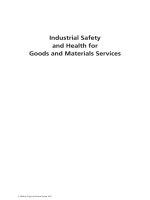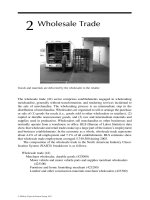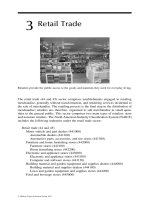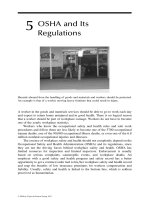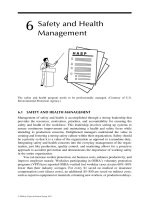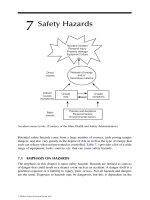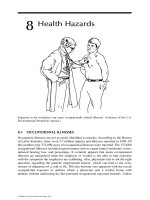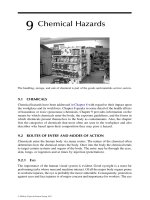Industrial Safety and Health for Goods and Materials Services - Chapter 4 potx
Bạn đang xem bản rút gọn của tài liệu. Xem và tải ngay bản đầy đủ của tài liệu tại đây (178.63 KB, 10 trang )
4
Warehousing
Warehousing was selected to be in this book because its function was to store
materials and goods that made the exposures of the workforce very similar to
those faced by workers in wholesale and retail trades. It is usually housed in the
same grouping as the transportation sector. The North American Industrial Classifi-
cation System (NAICS) lists it as follows:
Warehousing and storage (493000)
Warehousing and storage (493100)
Warehousing and storage facilities comprised 13,000 establishments in 2004.
These firms are engaged primarily in operating warehousing and storage facilities for
general merchandise and refrigerated goods (Figure 4.1). They provide facilities to
store goods; self-storage mini-warehouses that rent to the general public are also
included in this segment of the industry.
The deregulation of interstate trucking in 1980 encouraged many firms to add a
wide range of customer-oriented services to complement trucking and warehousing
services and led to innovations in the distribution process. Increasingly, trucking and
warehousing firms are providing logistical services encompassing the entire trans-
portation process. Firms that offer these services are called third-party logistics
providers. Logistical services manage all aspects of the movement of goods between
producers and consumers. Among their value-added services are sorting bulk goods
into customized lots, packaging and repackaging goods, controlling and managing
Warehouses are containers for the transfer and storage of goods and materials.
ß 2008 by Taylor & Francis Group, LLC.
inventory, order entering and fulfillment, labeling, performing light assembly, and
marking prices. Some full-service companies even perform war ranty repair work
and serve as local parts distributors for manufacturers. Some of these services, such
as maintaining and retrieving computerized inventory information on the location,
age, and quantity of goods available, have helped to improve the efficiency of
relationships between manufacturers and customers.
Many firms are relying on new technologies and the coordination of processes
to expedite the distribution of goods. Voice control software allows a computer
to coordinate workers through audible comm ands—telling workers what items to
pack for which orders— helping to reduce error s and increase efficiency. Voice
control software can also be used to perform inventory checks and reordering.
Some firms use radio frequency identification devices (RFIDs) to track and manage
incoming and outgoing shipments. RFID simplifies the receiving process by allow-
ing entire shipments to be scanned without unpacking a load to manually compare
it against a bill of lading. Just-in-time shipping is a process whereby goods arrive
just before they are needed, saving recipients money by reducing their need to carry
large invent ories. These technologies and processes reflect two major trends in
warehousing: supply chain integration, whereby firms involved in production,
transportation, and storage all move in concert so as to a ct with the greatest
possible efficiency; and ongoing attempts to reduce inventory levels and increase
inventory accuracy.
The average annual employment for warehousing is 555,800 workers. This
is approximately 0.4% of the U.S. workforce and 0.7% of the service industry
workforce.
FIGURE 4.1 Warehousing provides for the orderly staging and storage of goods and materials.
ß 2008 by Taylor & Francis Group, LLC.
4.1 PROFILE OF WAREHOUSING WORKERS’ DEATH, INJURIES,
AND ILLNESSES
4.1.1 D
EATHS
There were 27 deaths in the warehousing sector. These deaths account for 0.9% or
the total deaths (2736) in the service industry. As can be noted in Table 4.1, fall was
the most frequent cause of warehousing deaths.
4.1.2 INJURIES
There were 14,620 reported injuries for warehousing workers in 2004. The injury
rate for warehousing was 9.3 per 100 full-time workers, while it was 4.2 and 4.8 for
the service industry and all of private industry, respectively. This alarming injury rate
indicates the danger involved in the warehousing sector. The distribution for the
nature, body part, source, and exposure (accident type) for the 14,620 injuries are
presented in Tables 4.2, 4.3, 4.4, and 4.5, respectively.
4.1.3 ILLNESSES
In the warehousing sector, 1900 cases of occupational illness were reported; this is
1% of the total reported illnesses for the service industry. Table 4.6 provides the
breakdown of the illnesses.
4.2 HAZARDS FACED BY WAREHOUSING WORKERS
The fatal injury rate for warehousi ng is higher than the national average for all
industries. Warehousing is often viewed as not being a very complex operation, but
traffic patterns, fast pace, constant motion, and a myriad of various materials being
handled and stored lead to exposure to many hazards. Some of the most c ommon
hazards faced by warehouse workers are as follows:
.
Unsafe forklifts
.
Unsafe docks
.
Improper stacking or storage of materials
.
Failure to wear proper personal protective equipment
.
Conveyor hazards
.
Hazardous substances, materials, and chemicals
.
Manual lifting and handling task
.
Improper fueling and charging batteries
.
Poor ergonomic design
.
Potential fires
4.3 OCCUPATIONS
The handling and storage of materials require a workforce that is not the most highly
paid or skillfully qualified. The perception is that anyone can do warehousing type of
ß 2008 by Taylor & Francis Group, LLC.
work. However, the more experienced, trained, and skilled the workforce, the less
the chances of potential injury and death. With the use of computers and automated
equipment in warehouse, there is more of a presence of administrative types of
workers who spend most of their time in an office environment. (Safety and health
for office workers is covered in Industrial Safety and Health for Administrative
Services.)
Laborers and hand freight, stock, and material movers help load and unload
freight and move it around warehouses and terminals. Often, these unskilled employ-
ees work together in groups of three or four. They may use conveyor belts, hand
trucks, pallet jacks, or forklifts to move freight. They may place heavy or bulky items
TABLE 4.1
Occupational Death Cause by Percent
for the Warehousing Sector
Cause Percent
Highway 0
Homicides 0
Falls 15
Struck-by 0
Source: From Bureau of Labor Statistics, U.S. Department
of Labor. National Census of Fatal Occupational
Injuries in 2005. Available at http:==bls.gov.
TABLE 4.2
Nature of Injury by Number and Percent
for the Warehousing Sector
Nature of Injury Number Percent
Sprains=strains
a
6300 43
Fractures
a
940 6
Cuts=punctures
a
630 4
Bruises 1170 12
Heat burns ——
Chemical burns ——
Amputations ——
Carpal tunnel syndrome 230 1.5
Tendonitis 290 1.9
Multiple trauma
a
470 3
Back pain (only)
a
360 2
Source: From Bureau of Labor Statistics, U.S. Department of Labor.
Workplace Injuries and Illnesses in 2004. Available at http:==bls.gov.
a
Five most frequently occurring conditions.
ß 2008 by Taylor & Francis Group, LLC.
TABLE 4.3
Body Part Injured by Number and Percent
for the Warehousing Sector
Body Part Injured Number Percent
Head 640 4
Eyes 280 1.9
Neck 260 1.7
Trunk
a
6410 44
Back
a
3820 26
Shoulder
a
1250 8.5
Upper extremities
a
3070 21
Finger 620 4
Hand 760 5
Wrist 660 4.5
Lower extremities
a
3390 23
Knee 810 5.5
Foot and toe 1050 7
Body systems 50 0.3
Multiple body parts 800 5
Source: From Bureau of Labor Statistics, U.S. Department of Labor.
Workplace Injuries and Illnesses in 2004. Available at http:==bls.gov.
a
Five most frequently injured body parts.
TABLE 4.4
Source of Injury by Number and Percent
for the Warehousing Sector
Sources of Injuries Number Percent
Parts and materials
a
720 5
Worker motion=position
a
1810 12
Floor, walkways, or ground surfaces
a
1410 10
Hand tools 230 1.5
Vehicles
a
2390 16
Health care patient ——
Chemicals and chemical products ——
Containers
a
5030 34
Furniture and fixtures 730 5
Machinery 520 4
Source: From Bureau of Labor Statistics, U.S. Department of Labor.
Workplace Injuries and Illnesses in 2004. Available at http:==bls.gov.
a
Five most frequent sources of injury.
ß 2008 by Taylor & Francis Group, LLC.
on wooden skids or pallets and have industrial truck and tractor operators move them
(Figure 4.2).
Office and administrative support workers perform the daily recordkeeping
operations for the truck transportation and warehousing industry. Dispatchers
coordinate the movement of freight and trucks, and provide the main communication
link that informs the truck drivers of their assignments, schedules, and routes.
TABLE 4.5
Exposure=Accident Type by Number and Percent
for the Warehousing Sector
Type of Accidents Number Percent
Struck by object
a
1570 11
Struck against object 900 6
Caught in or compressed or crushed 590 4
Fall to lower level 450 3
Fall on same level
a
1110 7.6
Slips or trips without a fall 820 2
Overexertion
a
5720 39
Lifting
a
3700 25
Repetitive motion 530 3
Exposure to harmful substance or environment 80 0.5
Transportation accident
a
1170 12
Fires and explosions ——
Assaults=violent acts 80 0.5
Source: From Bureau of Labor Statistics, U.S. Department of Labor.
Workplace Injuries and Illnesses in 2004. Available at http:==
bls.gov.
a
Five most frequent exposures or type of accidents that led to an
injury.
TABLE 4.6
Occupational Illnesses by Number of Cases and Percent
for the Warehousing Sector
Illness Type Number Percent
Skin diseases and disorders 100 5
Respiratory conditions 0 0
Poisoning 0 0
Hearing loss 100 5
All others 1700 90
Source: From Bureau of Labor Statistics, U.S. Department of Labor.
Workplace Injuries and Illnesses in 2004. Available at http:==bls.gov.
ß 2008 by Taylor & Francis Group, LLC.
Dispatchers frequently receive new shipping orders on short notice and must juggle
drivers’ assignments and schedules to accommodate a client. Shipping, receiving,
and traffic clerks keep records of shipments arriving and leaving. They verify the
contents of trucks’ cargo against shipping records. They also pack and move stock.
Billing and posting clerks and machine operators maintain company records of the
shipping rates negotiated with customers and shipping charges incurred; they also
prepare customer invoices.
Sales and related workers sell warehousing services to shippers of goods. They
meet with prospective buyers, discuss the customers’ needs, and suggest appropr iate
services. Travel may be required, and many analyze sales statistics, prepare reports,
and handle some administrative duties.
Managerial staff provides general direction to the firm. They staf f, supervise,
and provide safety and other training to workers in the various occupations. They
also resolve logistical problems such as forecasting the demand for transportation,
mapping out the most efficient traffic routes, ordering parts and equipment service
support, and scheduling the transportation of goods.
FIGURE 4.2 Although forklifts are useful, they pose danger when misused.
ß 2008 by Taylor & Francis Group, LLC.
Many jobs in the wareh ousing industry require only a high school education,
although an increasing number of workers have at least some college education.
College education is most important for those seeking positions in management.
Increasing emphasis on formal education stems from the increasing use of techno-
logy in the industry. Nearly all operations involve computers and information
management systems. Many occupations—especially those involved in scheduling,
ordering, and receiving—require detail-oriented people with computer skills.
A growing number of employers recommend some form of formal training. Some
companies provide such training in-house. Other sources of training include trade
TABLE 4.7
Twenty Nine Most Frequent OSHA Violations for the Warehousing Sector
Standard Number Cited Description
1910.178 258 Powered industrial trucks
1910.1200 141 Hazard communications
1910.305 112 Wiring methods, components, and equipment for general use
1910.37 97 Maintenance, safeguards, and operation features of exit routes
1910.303 96 General requirements
1910.157 68 Portable fire extinguishers
1910.132 67 Guarding floor and wall opening and holes
1910.147 59 The control of hazardous energy (lockout=tagout)
1904.29 49 Forms
5A1 45 General duty clause
1910.134 44 Respiratory protection
1910.151 44 Medical services and first aid
1910.1030 44 Bloodborne pathogens
1904.41 39 Annual OSHA injury and illness survey of 10 or more employees
1910.215 39 Abrasive wheel machinery
1910.22 37 General requirements
1910.212 35 General requirements for all machines
1910.176 34 Handling materials, general
1910.304 29 Wiring design and protection
1910.36 26 Design and construction requirements for exit routes
1910.146 24 Permit-required confined spaces
1904.32 20 Annual summary
1910.253 20 Oxygen-fuel welding and cutting
1910.119 19 Process safety management of highly hazardous chemical
1910.106 18 Flammable and combustible liquids
1910.110 17 Storage and handling of liquefied petroleum gases
1910.219 16 Mechanical power-transmission apparatus
1910.133 15 Eye and face protection
1910.141 14 Sanitation
Source: From Occupational Safety and Health Administration, U.S. Department of Labor. Available at
http:==www.osha.gov.
ß 2008 by Taylor & Francis Group, LLC.
associations, unions, and vocational schools. Many companies have specific curri-
cula on safety and procedural issues, as well as on occupational duties.
4.4 APPLICABLE OSHA REGULATIONS
One of the best ways to understand the hazards faced by utility workers is to see the
types of violations that the Occupational Safety and Health Administration (OSHA)
has found during their inspections of the workplace. These violations provide another
way of targeting hazards that have the potential to cause injury, illness, and death of
workers. As can be seen from the 30 most frequently cited violations, OSHA cites this
industry under the general industry standard (29 CFR 1910) (Table 4.7).
Although the violations cited in Table 4.7 were the 30 most frequently issued
violations, OSHA has cited other hazards with less frequency. Some of these are as
follows:
.
Woodworking machinery
.
Overhead cranes and gantry cranes
.
Hazardous waste operations and emergency response
.
Hand protection
.
Asbestos
.
Portable metal ladders
.
Emergency action plans
.
Fixed industrial stairs
.
Hand and portable power tools
.
Arc welding and cutting
.
Occupational noise exposure
.
Compressed gases
.
Foot protection
With the hazards faced by this sector, it is imperative that safety and health be
an integral part of doing business and with the specific purpose of protecting its
employees.
REFERENCES
Bureau of Labor Statistics, U.S. Department of Labor. National Census of Fatal Occupational
Injuries in 2005. Available at http:==bls.gov.
Bureau of Labor Statistics, U.S. Department of Labor. Workplace Injuries and Illnesses in
2004. Available at http:==bls.gov.
Occupational Safety and Health Administration, U.S. Department of Labor. Available at
http:==www.osha.gov.
ß 2008 by Taylor & Francis Group, LLC.
ß 2008 by Taylor & Francis Group, LLC.

